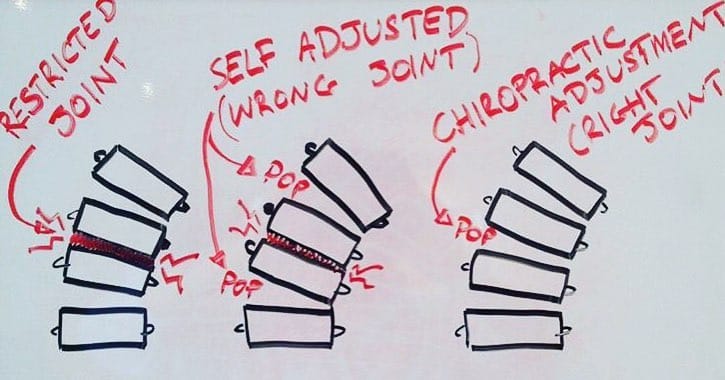Self Adjustment vs. Chiropractic Adjustment

I meet people every day who pop or crack their own neck and back. People do this “self-manipulation” to give themselves temporary relief of pain and stiffness, and it quickly becomes an easy habit that they repeat throughout the day. It feels good, so they keep doing it.
However, the relief from a self-manipulation does not last. “So, what about when a chiropractor pops the joint? What is the difference?” Chiropractors are well known for performing joint adjustments. An adjustment is a quick and shallow force, directed into a joint, to help it move more freely throughout its range of motion. This adjustment is often, but not always, accompanied by a popping sound. A chiropractic adjustment has several characteristics that make it different from a self-manipulation. One of the most important differences is specificity: the ability to direct an adjustment towards an individual joint and in a chosen direction. This specificity comes with years of training in palpation, spinal anatomy, force vectors, and of course practice. Self-manipulation is completely non-specific. In fact, when someone self-manipulates their neck, they are more than likely moving and popping the joint that is already moving the most, rather than the joint that is “stuck” and producing the pain and stiffness. This non-specific movement is why the relief from self-manipulation is temporary. Temporary relief occurs because of an automatic release of endorphins (feel-good chemicals) that occurs when a joint is manipulated. However, lasting relief does not occur because the source of the symptoms is still there. The restricted joint that was stiff and causing pain is still stuck, while the joint next to it is moving more than ever. In contrast, during an adjustment, the chiropractor finds and adjusts the stuck joint to help resolve the restriction and provide longer-lasting pain relief.

Let’s go back to that popping sound. The pop is called a cavitation, and is caused by a process called tribonucleation. Basically, when the joint surfaces get pulled apart, there is a certain point when the fluid inside the joint cannot expand any more and a gas layer is created. The formation of the gas layer causes a cavitation and a “POP!” After all this talk of joint popping and cavitations, I need to make something clear: the popping sound is not important. Cavitations themselves are unrelated to the pain-relief experienced after an adjustment. The pain-relief instead comes for the improvement in joint motion, relaxation of muscles, and reduction in nerve irritation that results from the adjustment. So, the next time you go to twist and pop your own spine, think about that stuck joint and consider getting a chiropractic treatment to help resolve the underlying issue. - Dr. Caitlyn Cameron, DC
Archive
- ► 2024 (5)
- ► 2023 (4)
- ► 2022 (9)
- ► 2021 (5)
- ► 2020 (5)
- ► 2019 (5)
- ► 2017 (5)
- ► 2016 (5)
